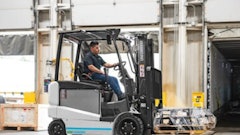
Many excavator manufacturers offer a choice of working modes. These typically work by controlling the engine speed, and therefore the flow from the pump.
Caterpillar offers three working modes: high power, standard power and economy. “When it leaves the factory, it is in the high horsepower mode,” says Kent Pellegrini. The proper application of these work modes is dependent upon your application and what you want to save in fuel vs. the desired production. “High power is pretty much the standard.”
He notes, “We run at 1,800 rpm on engine speed. When you go down to standard mode, you are at 1,700 rpm. When you go to economy mode, you are at 1,700 rpm but we de-stroke the pump.” This reduces the power of the pump. “You become hydraulically limited when you are in economy mode. You don’t have the pressure. But economy mode is for fine grading and really light-duty applications.”
Standard mode saves fuel by lowering the engine speed. When you want more production, you simply select high power. “In North America, not many operators use standard power,” says Pellegrini. “It’s just the way operators run. They want to get the work done now.”
However, Standard and Economy modes are very popular with European operators. “Economy mode can be used for leveling, real light loading and real fine precision work,” says Pellegrini. “In Europe, when they do fine grading, they don’t want all of that power coming out to the front end of the machine. They want to reduce it down to keep the rpm as low as they can get while maintaining controllability.”
Economy mode is starting to catch on in North America. “If fuel prices keep going the way they are, people are going to start falling back to these fuel modes,” says Pellegrini. “We are ready for it. We have technology in place now where it is going to really help.”
Expanded Selection
Komatsu has also expanded its available work modes. “The Dash 10 excavators feature six working modes, which is one more than the previous models,” notes Brian Yureskes. “The operator now has the ability to run attachments in the Economy mode, which was previously unavailable. This additional mode provides a fuel-efficient option in lower load applications.”
But being able to maximize efficiency with this system does require training. “It is important for operators to understand which work modes maximize machine efficiency in each application,” Yureskes states. “Operators can easily select or change work modes on the monitor panel.”
Volvo Construction Equipment is also a proponent of selectable working modes. “Volvo excavators have selectable working modes right at the throttle control to make it easier on the operator,” says Joe Escalante.
The four selectable modes include H for extremely hard digging operations; G for general applications and maximum fuel savings; F for precision grading and maximum lifting power; and L for low idle and warm-up. “The operator simply selects the working mode through the throttle control and goes to work,” says Escalante.
Because not every job is best suited to working at full throttle, Escalante highly recommends training on the proper use of the working mode system. “A lower working mode may make an operator faster than putting the machine in H mode and fighting the machine. It becomes a fight of brain and muscle vs. machine hydraulics and computers,” he points out. “We not only control the engine speed, but also the pump flow output, so it makes it a lot easier for maximum efficiency.”




















